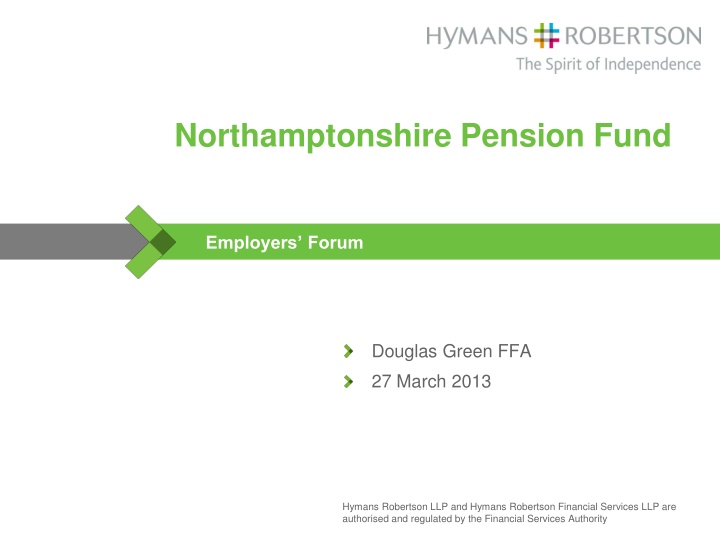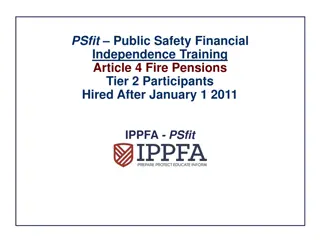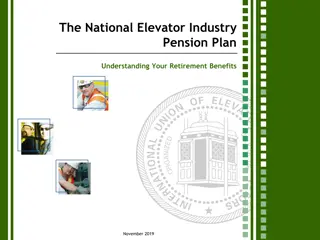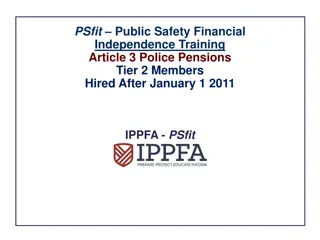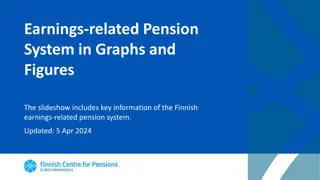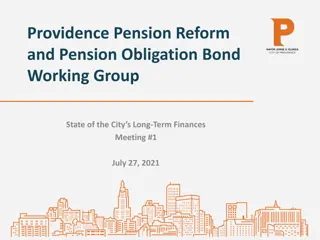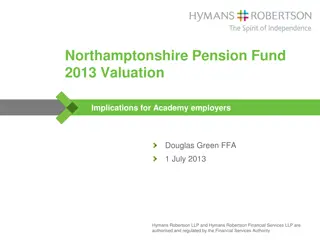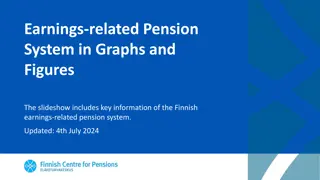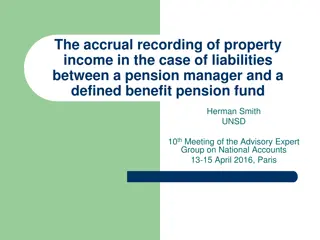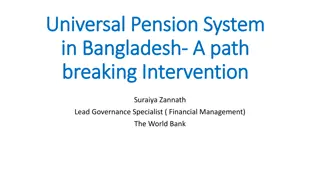Northamptonshire Pension Fund Employers Forum Discussion Highlights
Delve into the insights from the 2013 Northamptonshire Pension Fund Employers Forum on actuarial valuations, employer contributions, data submissions, and the impact of information on benefit and liability levels. Learn about the key focus areas for employers and the preparation needed for the valuation process.
Download Presentation

Please find below an Image/Link to download the presentation.
The content on the website is provided AS IS for your information and personal use only. It may not be sold, licensed, or shared on other websites without obtaining consent from the author.If you encounter any issues during the download, it is possible that the publisher has removed the file from their server.
You are allowed to download the files provided on this website for personal or commercial use, subject to the condition that they are used lawfully. All files are the property of their respective owners.
The content on the website is provided AS IS for your information and personal use only. It may not be sold, licensed, or shared on other websites without obtaining consent from the author.
E N D
Presentation Transcript
Northamptonshire Pension Fund Employers Forum Douglas Green FFA 27 March 2013 Hymans Robertson LLP and Hymans Robertson Financial Services LLP are authorised and regulated by the Financial Services Authority
Todays discussion Preparation for the 2013 valuation Outlook for 2013 valuation Employer issues Varying types LGPS Reform Proposed changes in State Pension Ask questions as we go along! 2
Purposes of an actuarial valuation We have to! Recommend employer contribution rates Assess past service deficit and future service cost Monitor experience vs. Assumptions Formal review required every 3 years 4
2013 valuation: what employers need to do 1. Liaise with pensions team 2. Data correct and up to date 3. Watch out for communications 4. Look out for Funding Strategy Statement (FSS) consultation 5
Data submission for the 2013 Valuation Rely on accuracy of membership data Administering Authority require information from employers Changes in membership Correct salaries/contributions paid Missing/incorrect data could result in: A higher value being placed on future benefit promises A higher contribution rate Additional fees for you 6
What information can impact on benefit and liability levels? Name Date of Birth Certificates of Protection Officer/Manual Worker NI Number Pensionable Pay Title Final Pay Opt-outs Full-time Hours Maiden name Marital Status Employer Additional Contributions Date of Joining Reason for leaving Spouse s details Address Added Years Date of Leaving Year end info Part-time Hours C/O Earnings Contribution Rate Augmentation Opt-ins NI Class Service Credit - transfers 7
Most important data items Pensionable Pay Date of birth Length of service 8
Impact of incorrect data Example (Active Member) FTE Salary Liability Sex DOB Service Date M 01/01/1956 01/01/1989 15,000 75,000 M 01/01/1956 01/01/1989 10,500 50,000 M 01/01/1965 01/01/1989 10,500 40,000 M 01/01/1965 01/01/1998 10,500 25,000 9
Valuation timetable March 2013 December 2013 March 2014 New Rates Payable Q1 2014 Q2 2013 Q3 2013 Q4 2013 Q1 2013 Preparation for valuation Data for actuary Actuary does his sums Valuation results Consultation on FSS Finalise employer contributions 10
Market movements since 2010 Sterling total returns of UK equities (rebased to 100 at 31 Mar 2010) 130 125 120 115 110 105 100 95 90 85 80 31 Mar 2010 31 Mar 2011 31 Mar 2012 UK equities (FTSE All Share) Discount rate unwinding Assets slightly better than expected 12
Sovereign Debt Crisis and the impact on government bond yields 6.00% 5.50% 5.00% 4.50% 4.00% 3.50% 3.00% 2.50% 2.00% 2001 2002 2002 2003 2004 2005 2006 2007 2007 2008 2009 2010 2011 2012 FTSE UK Gilts Annual Yield Series (over 15 years) Implied Inflation Lower long term yields mean higher liabilities/deficits 13
Likely impact of key drivers since 2010 Key driver Investment returns Deficit Contribution rate Market conditions Life expectancy New LGPS 2014 Overall Impact 16
Outlook for 2013 Compared against 2010 valuation: Funding levels likely to be lower Deficits likely to be bigger (Theoretical) contribution rates likely to be higher Recommend contributions split % of pay and Results will vary significantly between employers Actuary helps Fund to work with you 17
Within each employer in the fund: Assets and liabilities individually tracked Deficit = Liabilities less Assets a) Assets Employer conts Benefits to ex- employees Employer sub-fund Member conts Investment gains b) Liabilities: see next few slides 19
Liabilities employer specific Active Membership 20
Liabilities employer specific Pensioners 21
Every employer is different Range of employer funding levels Hot spot 50 45 40 Number of employers 35 30 25 20 15 10 5 0 Funding Level Source: Hymans Robertson, based on Northamptonshire Pension Fund as at 31 March 2010 22
Every employer is different Range of employer total theoretical contribution rates 120 100 Number of employers 80 60 40 Hot spot 20 0 Contribution Rate (% of payroll) Source: Hymans Robertson, based on Northamptonshire Pension Fund as at 31 March 2010 23
Assessing employer covenant Issues What is risk of employer leaving Fund? What is risk to Fund if employer leaves? Employer risk Tax-raising powers Type of body (Scheduled, TAB, CAB) Open or closed to new entrants Guarantor in place? Financial strength Funding position/size of liabilities Heading to cessation? 24
Less secure & shorter-term employers Challenge: protect the Fund avoid pushing employers into insolvency Reconsider deficit recovery Seek additional security Understand the risks Assess the likelihood of meeting target funding 25
Most secure longer term employers Longer term view can be taken Consider stabilising contributions 26
New LGPS from 2014: funding impact Existing Scheme Proposed New Scheme Final Salary CARE with CPI revaluation Benefit Type 1/60th 1/49th Accrual Rate 65 State Pension Age Retirement Age Average 6.5% Full-time equiv. pay Average 6.5% Actual pay Member Contribution Rate Non contractual overtime excluded Non-contractual overtime included Pensionable Salary Accrued rights protected (incl. retirement age, R85, final salary link) Existing scheme underpin for members within 10 years of NPA (age 65) at 1 April 2012 ( best of ) Introduction of a 50/50 option to bolster LGPS participation 28
Impact on benefits of LGPS reform Assume CPI = 2.0% p.a. Salary Growth = 4.0% p.a. Example 1 Member aged 45, Expected to retire at 65, Salary 18,000 Expected pension earned in next year:- Old Scheme - 1/60 x 18,000 x 1.0420 = 657 300 New Scheme - 1/49 x 18,000 x 1.0220 = 545 367 29
Impact on benefits of LGPS reform Assume CPI = 2.0% p.a. Salary Growth = 4.0% p.a. Example 2 Member aged 60, Expected to retire at 65, Salary 18,000 Expected pension earned in next year:- Old Scheme - 1/60 x 18,000 x 1.045 = 365 300 New Scheme - 1/49 x 18,000 x 1.025 = 405 367 30
LGPS 2014 impact on employers Taken in isolation... No impact on existing deficits (past service) Accrued rights to 2014 are protected Modest savings on new benefits (future service) c1%-2% of pay across whole fund? Savings will vary by employer: Depends on membership profile Changes to member contributions Take up of 50/50 option pay profile ... but cannot take in isolation! 31
Proposed changes to State Pension Contracting out abolished (2017 at the earliest) Single tier pension for all ( 144 per week) Current basic state pension = 107.45 per week Contracting out NIC rebate removed 33
Contracting Out NIC Rebate Applies to gross salary between 5,564 and 40,040 (in 2012/13) Employer rate is 3.4% (in 2012/13) Employee rate is 1.4% (in 2012/13) 34
Next steps Pensions reform to be finalised Accurate and timely data to be submitted Fund acknowledges different types of employer Increases in contributions probably required Keep in close touch with the Pensions Team!! 36
